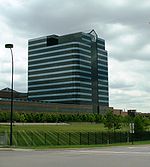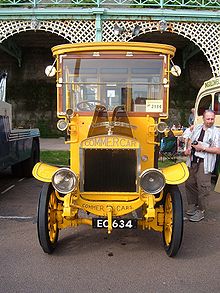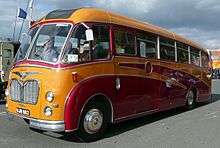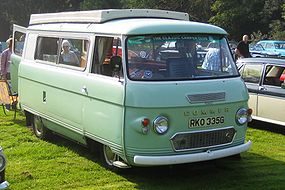- Commer
-
Commer Fate Discontinued Founded 1905 Headquarters Luton, England Products Commercial vehicles Commer was a British manufacturer of commercial vehicles which existed from 1905 until 1979. Commer vehicles included car derived vans, light vans, medium to heavy commercial trucks, military vehicles and buses. The Commer brand was exported widely, with examples, albeit collectors' vehicles, still running far from the UK manufacturing base.[citation needed] Commer designed and built its own diesel engine for its heavy commercial vehicles.
Contents
History
The company was formed as the Commercial Car Company based in small premises in Lavender Hill, South London. In order to go into volume production a site was bought at Biscot Road, Biscot, Luton, where production of the first truck, the 3 ton RC type started in 1907. In 1909 the first bus was made. With the outbreak of First World War the factory turned to the manufacture of military vehicles for the British Army and by 1919 over 3000 had been made.
In 1926, after being in receivership several times, Commer was taken over by Humber, which in 1931 became part of the Rootes Group.
The Commer name was replaced by the Dodge name during the 1970s following the takeover of Rootes by Chrysler Europe. After Peugeot purchased Chrysler Europe in 1978, the Commer factory was run in partnership with the truck division of Renault, Renault Trucks. It continued to produce the Dodge commercial truck range for some time, with Renault badges and a small amount of product development, eventually these were cancelled in favour of mainstream Renault models and switching production at the factory to production of Renault truck and bus engines in the early 1990s.
Many Commer vans and lorries are notable for being fitted with the Rootes TS3 engine, a two-stroke diesel three-cylinder horizontally-opposed piston engine, which came to be known as the "Commer Knocker" due to the unique noise it produced.[1] Newer Commer vehicles had Perkins and Cummins diesel engines, and less commonly Mercedes diesel engines. [2]
Trucks
Karrier
Commer acquired the Karrier company as part of Rootes acquisition of Karrier in 1934. In 1965 production moved to Dunstable where Commer, Dodge (UK) and Karrier were all brought together.
The Karrier trademark is now owned by Peugeot.
Buses
Commer produced buses and is recorded as delivering four to Widnes in 1909.[3] The Commando was released after WW2, and the Avenger on 28 February 1948, deploying the TS3 engine in the Avenger in 1954.[4]
Light commercial vehicles
Cob
The Cob was a small delivery van based upon the Hillman Husky.[5] Later models were based upon the Hillman Imp.[6]
Commer BF
Many examples of these vans were coach built as ice cream vans.[7]
Commer FC/PA/PB/Spacevan
Commer FC Manufacturer Rootes Group
Chrysler EuropeProduction 1960-1982 Successor none Body style Forward control panel van. Numerous conversions and adaptations to special purposes Engine 1500 cc Straight-4
1725 cc Straight-4[8]Transmission 4 speed manual
4-speed manual + Laycock Overdrive (from 1973)[8]Length 170 in (4,318 mm) [8] Width 75 in (1,905 mm) [8] Commer became known in later years as a maker of vans for the British Post Office—particularly the Commer FC which was introduced in 1960 with many body styles, including a 1500 cc van. After engine and interior upgrades it was renamed the PB in 1967 and the SpaceVan in 1974. As noted above, it would be sold as a Dodge and Fargo model until 1976, when both Commer and Fargo names were dropped. These were rounded-front forward control vans with narrow front track—a legacy of their Humber car-derived suspension. Utilising at first the Hillman-derived 1500 cc 4-cylinder engine in the PA series, then the larger 1600 cc, and from 1968 onwards the 1725 cc unit in the PB, only the cast iron head version of this engine were used. A Perkins 4108 diesel was also available.
The "1725 cc engine" (as it is known; it actually displaces 1724 cc) was available in the 1970s with a Borg Warner (BW) Model 35 3-speed automatic transmission with a dashboard mounted selector. This was not a popular option and few were built.
The 4-speed gearbox on manual transmission models was based on those fitted to contemporary Hillman Minx (of the "Audax" generation) and later Rootes Arrow series cars such as the Hillman Hunter.
An unusual feature of the model was that the handbrake operated on the front drum brakes.
One of the reasons that the van was less popular with fleet operators than the Bedford and Ford Transit models it sold against was that, as on the BMC J2 and J4 models the forward-control design restricted access to the engine and made engine changes labour intensive: the only way to remove the engine without dropping the suspension subframe was to remove the windscreen and crane the engine out through the passenger door. A 1974 road test of a motor caravan version fitted with the 1725 cc engine reported a maximum speed of 70 mph (113 km/h) and a 0-50 mph (km/h) time of 25 seconds, indicating a higher top speed but, in this form, slower acceleration than the BMC competitor.[8] However, the testers reported that at 70 mph the van was "plainly at its absolute limit, screaming away in a most distressing fashion":[8] readers were advised to view 65 mph (105 km/h) as a more realistic absolute maximum.[8] Rumours that Rootes planned to fit Spacevans with leftover Ford V8s from the end of Sunbeam Tiger production have proved to be unfounded, largely because as Billy Rootes put it, (it was a) "Bloody stupid idea"[citation needed]
Reportedly, one condition of the government bailout of Chrysler's British operations in 1976 was a commitment to upgrade the Spacevan, which was praised for its brakes, cornering, and price, but criticized for its power, comforts, and top speed.[2] A revised Spacevan was thus introduced in 1977, using the same mechanicals but with numerous cosmetic changes, conveniences, and a new interior. Although outdated by its demise in 1982, by which time Commer had been taken over by Peugeot, the Spacevan remained a familiar sight in the UK thanks to its role with British Telecom and the Post Office—which were almost solely responsible for it remaining in production for so long. By this time, there were three engines: two 1.7 L petrol engines of 37 kW (with low compression) and 42 kW (with high compression), and a small diesel engine (31 kW), with a four-speed manual transmission and no automatic available. The last Spacevan was built in 1983.[9]
Military vehicles
Commer made a range of military vehicles for WW2, with the range still in use in the 1980s. During the war, British humourist Frank Muir, serving in the army, reported a broken down vehicle over his radio with the words "The Commer has come to a full stop."[10]
Engines
Commer designed and manufactured its own diesel engines for its heavy commercial vehicles and buses. They were low profile units designed to be deployed under the floor of the cab.
TS3
The TS3 engine was a two stroke diesel unit with three cylinders each containing a pair of pistons arranged with the combustion chamber formed between the crown of the piston pair and the cylinder walls. It was designed specifically for the Commer range of trucks.[11] The TS3 and derivative TS4 were unique in using rockers to deliver power to the single crankshaft.[12]
TS4
The TS4 engine ran 1.2million miles as a pre-production prototype. It was a 4 cylinder version of the TS3.[13]
See also
- Dodge 50 series
- Dodge 500 trucks
References
- ^ "The TS3". http://www.commer.org.nz/Commer_Connections/Other.html. Retrieved 2008-11-04. "The engine was a direct injection, high speed diesel engine with three horizontal cylinders, each containing two pistons. Each cylinder had specially designed ports to control the inlet of air and outlet of the exhaust which are controlled by the pistons. The pistons which control the inlet ports are known as the air pistons (left-hand side of the engine) and the pistons which control the exhaust ports are the exhaust pistons."
- ^ a b "Dodge Spacevan / Telecom Van (Fargo F-series, Dodge K-series, Commer PA and PB vans)". Allpar. Allpar LLC. http://www.allpar.com/squads/spacevan.html. Retrieved 18 August 2010.
- ^ ""Commer" Commercial Cars Ltd Luton". http://www.holmes.pwp.blueyonder.co.uk/commer_details.htm. Retrieved 2008-11-05. "These four vehicles took 4 days to be delivered from Luton to Widnes in 1909. There was no motorways, roads were in general very poor and at a height of 16ft 6ins "still very high for a vehicle nowadays" quite a few tree branches had to be cut down to get to Widnes."
- ^ "Avenger Bus". http://www.commer.org.nz/Commer_Connections/Avenger_Bus.html. Retrieved 2008-11-05. "While not as common as other bus chassis, many excellent bodies were mounted on Avenger chassis, including Duple, Harrington and others."
- ^ "Old Commer van photograph in the archive at Classic Wheels". Classic Wheels. http://www.classic-wheels.co.uk/old_commer_cob.htm. Retrieved 2008-11-05.
- ^ "1968 Commer Cob van APP520F at the Woodley Classic Car Meet, April 2007". http://ccmv.fotopic.net/p40329107.html. Retrieved 2008-11-05.
- ^ http://whippy.com.au/
- ^ a b c d e f g "Easy living, hard driving: Commer Auto0-sleeper C20 two berth". Autocar 141 (nbr 4074): page 26. date 23 November 1974.
- ^ "Dodge Spacevan / Telecom Van (Commer PA and PB vans, Dodge K-series)". allpar.com. Allpar, LLC. http://www.allpar.com/squads/spacevan.html. Retrieved April 2008.
- ^ "Truck 3 ton 4 x 4 GS Commer Q4". REME Museum of Technology. http://www.rememuseum.org.uk/vehicles/mwv/vehcomq4.htm. Retrieved 2008-11-05. "Among the longest living of the Commer workshop trucks was the Telecommunications Repair variant, some being used into the late 1980s or later."
- ^ "The TS3". http://www.commer.org.nz/Commer_Connections/Other.html. Retrieved 2008-11-05. "The TS3 was initially designed by Rootes Power Units Chief Engineer Eric W Coy (and under him, designers Bennett and Mileluski) at the Humber plant (Stoke-Aldermore) in 1948. It was designed solely to meet Rootes production planning requirements for an underfloor 105hp diesel engine for the new forward control Commer range of heavy trucks."
- ^ "Other Two Strokes". http://www.commer.org.nz/Commer_Connections/Other_2_Strokes.html. Retrieved 2008-11-05. "Many two-strokes used opposed piston layouts, but the design feature that set the TS3/4 apart from other two-strokes was the use of rockers to transmit power from the piston to the crankshft and the use of a single crankshaft."
- ^ "The TS4 Prototype". http://www.commer.org.nz/Commer_Connections/TS4_Motor.html. Retrieved 2008-11-05. "All the 14 prototype TS4s were test bed run initially. Six stayed in test bed work and eight were put in trucks for road evaluation, prior to going into production. The engines that were put in trucks ran up to 1.2 million miles between the 8 of them, trouble free, before being pulled out and scrapped on instructions from Chrysler to protect Chrysler’s joint venture in England with Cummins."
External links
- Rootes-Chrysler resource site
- FleetData's history of Commer
- Commer pictures form Classic Motor Vehicle
- Commer Van Fan
- Transport Historisk galleri
Chrysler Marques CurrentDefunctAMC (1966–1988) · Commer (1905–1979) · Barreiros (1959–1978) · DeSoto (1928–1961) · Eagle (1988–1998) · Fargo (1920–1972) · Hillman (1907–1976) · Humber (1898–1975) · Imperial (1955–1975, 1981–1983) · Karrier (1908–1977) · Plymouth (1928–2001) · Singer (1905–1970) · Simca (1934–1977) · Sunbeam (1901–1976) · Valiant (1960–1966)
Divisions and
subsidiariesCurrentChrysler Australia · Chrysler Canada · Dodge · Jeep · Mopar · Ram Trucks · Street and Racing TechnologyDefunctAmerican Motors Corporation (1954–1988) · Chrysler Australia (1951–1981) · Chrysler Europe (1967–1981) · Chrysler-Plymouth · Chrysler UK (1970–1981) · EnviFormerJoint ventures and
alliancesCurrentDefunctPeople Walter Chrysler · Lee Iacocca · C. Robert Kidder · Thomas W. LaSorda · Sergio Marchionne · Louis RhodesPlaces Products Other Big Three · Cerberus Capital Management · Daimler-Chrysler (1998–2007) · Fiat SpA · History (Chapter 11 reorganization)
 Category ·
Category ·  CommonsCategories:
CommonsCategories:- Rootes
- Truck manufacturers
- Defunct truck manufacturers of the United Kingdom
- Bus manufacturers
- Defunct bus manufacturers of the United Kingdom
- Companies established in 1905
- Companies disestablished in 1979
Wikimedia Foundation. 2010.



